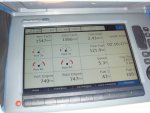Re: GPS, charts, fuel flow, FF combos. What set up do you have?
Data about fuel flow can come from a direct-reading sensor, usually a small turbine sensor inserted into the fuel line, or from the engine itself, if the engine is modern and has electronically controlled fuel injectors. Such engines typically know quite precisely how much fuel they are using because they are directly controlling the flow themselves.
Fuel flow measured with a turbine sensor can be displayed in two general ways: on a dedicated display device associated with the fuel flow measurement system, or on a multi-purpose display which can read the data from the sensor. Typically a multi-purpose display will be one with a NMEA-2000 interface. NMEA-2000 is the modern standard for electronic communication on boats. Note that a GPS receiver or a SONAR or fish finder are not needed for display of fuel flow. You just need a multi-function display.
Many multi-functions displays include a chart plotter and sometimes an internal GPS receiver and internal SONAR. Most of these modern displays have a NMEA-2000 interface so they can integrate with other vessel electronics using the modern NMEA-2000 standard.
A fuel flow sensor that is NMEA-2000 compliant will send NMEA-2000 data about fuel flow which can be read by a multi-function display that is able to handle that data. NMEA-2000 data is sent in parameter groups which are numbered. If you use a turbine sensor, the sensor will indicate what NMEA-2000 parameter it is sending. Look for a display that can read that parameter.
A typical turbine fuel flow sensor that is NMEA-2000 compliant is the Lowrance EP-60R. See
http://www.lowrance.com/en-US/Products/NMEA-2000/EP-60R-Fuel-Flow-en-us.aspx
The specification for this sensor show that it sends PGN 127489.
A modern engine also will typically send information about its fuel flow in the standard engine dynamic parameter group, PGN 127489. In order to take advantage of this data, you will need a display that can read PGN 127489. According the NMEA, devices used with NMEA-2000 networks should provide a list of PGN's they can either send or receive. This means you can easily match up a display with a sensor. It seems almost universal that modern multi-function displays for marine use can handle PGN 127489, and similarly universal that all modern engines will send it. One caution: there are no Brunswick engines in either their Mercury brand or Mercruiser brand that can send any NMEA-2000 data; they are not NMEA-2000 devices. For Brunswick engines you have to invest in a protocol convertor to get the data from the Brunswick protocol, which they call Smartcraft, to the universal standard of modern boat electronics, NMEA-2000.
As for my experience, I have measured fuel flow both ways, with a turbine sensor and with electronic data from a NMEA-2000 engine. Modern outboard engines tend to have very low rates of fuel flow at idle. The relatively inexpensive turbine flow sensors typically cannot measure fuel flow very accurately at the flow rates of a modern outboard engine at idle or low speed. For this reason the turbine sensor may not be a good choice.
For more about the two most common NMEA-2000 parameter groups associated with engine data, see
http://continuouswave.com/whaler/reference/PGN.html



















